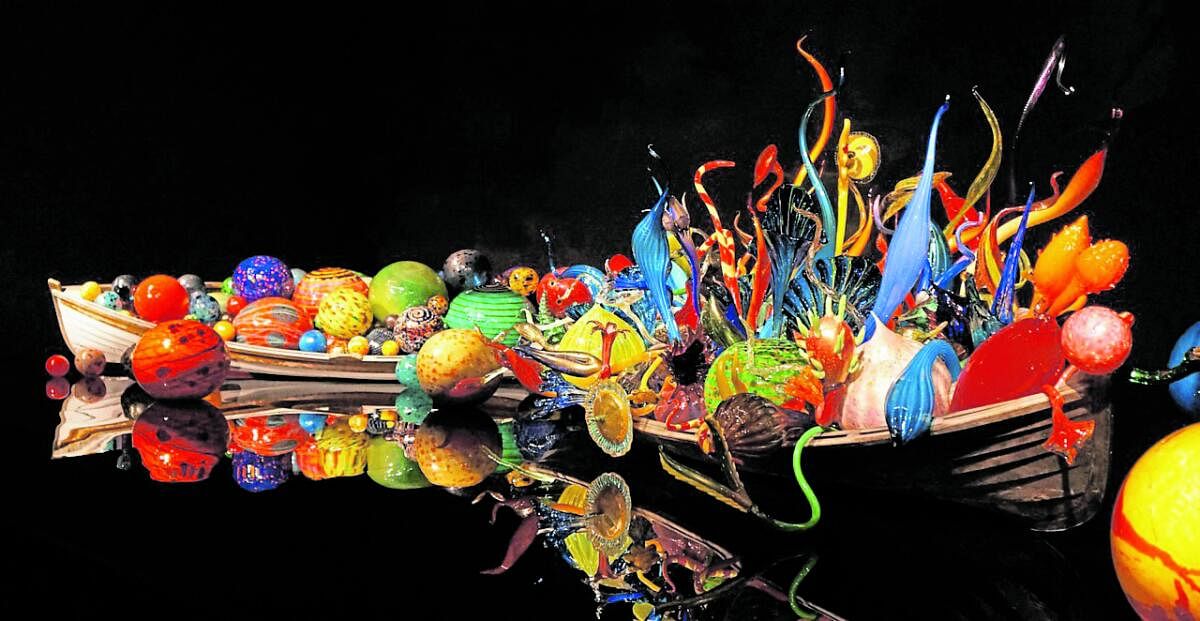

One of the finest experiences while in the West Coast American city of Seattle is a visit to the Chihuly Garden and Glass. Located in the vicinity of the city’s iconic Space Needle, this permanent exhibition consisting of eight galleries, a centrepiece glasshouse and a lush garden, houses some of the best artworks of American glass artist and entrepreneur Dale Chihuly.
Celebrated for his large-scale architectural installations, the 81-year-old Chihuly was introduced to glass while studying interior design at the University of Washington. After graduating in 1965, he enrolled in the first glass programme in the country at the University of Wisconsin. He continued his studies at the Rhode Island School of Design. A Fulbright scholarship allowed him to work at the Venini glass factory in Venice in 1968, where he learnt all the secrets and trades of Murano glass blowing. In 1971, Chihuly co-founded the Pilchuck Glass School in Washington State. Today, his work is included in more than 200 museum collections worldwide. Over the years, he has received many awards, including 12 honorary doctorates and two fellowships from the National Endowment for the Arts.
Like all artists, Chihuly draws inspiration from the world around him. Born and raised in Washington State, his muses include the waters of the Puget Sound, his mother’s gardens in Tacoma and the art of several indigenous tribes. “I made the Sealife Tower to show how important water is to my work,” he explains in the exhibition’s audio tour. In 1992, Chihuly started the Chandelier series with the Seattle Art Museum. His installation, Winter Brilliance, is an icicle form in glass. “I’ve worked with ice several times; one of my favourite materials because of the way it works with light,” says Chihuly.
The Persian series started out with his interest in Persian, Roman and Egyptian glass. The forms in Mille Fiori, which in Italian means “a thousand flowers”, have been inspired by work that Chihuly has done in Waterford Crystal, Ireland and Monterey, Mexico. The exquisite Ikebana and Float Boat series was inspired by his experience in Nuutajarvi, Finland in the mid-1990s. “It’s a combination of the glassblowing process and inspired by places that I’ve visited over the years,” he reflects.
The Glasshouse and the Garden have been completely designed by Chihuly. A 40-foot tall glass and steel structure covering 4,500 square feet of lit-up space, the Glasshouse is filled up with a single gigantic piece of red, yellow and orange sculpture that is 100 feet long, 25 feet high and weighs 10,000 pounds. One of Chihuly’s largest suspended sculptures, the perception of the artwork varies greatly with natural light and as the day fades into night.
The Garden, with an area of about 26,000 square feet, has, among other things, a yellow-green tower, a red tower, a yellow sun, a red Mexican hat tower, and a green icicle tower. Chihuly personally picked all the plants that are in the garden space. The Viola Crystal Tower, named after Chihuly’s mother, is the only piece in the space that is made from a polymer that he developed called Polyvitro which mimics glass. Further, the Citron Icicle Tower, the largest in the series, is over 32 feet tall. Chihuly created the longest series, in black, when his mother passed away in 2006. The Pacific Sun, 16 feet in diameter, is the largest one Chihuly has ever made. With 1,200 different elements inside, it gives the illusion of the sun orbiting in space.
The exhibition also includes live demonstrations on flameworking, in which local artists offer a closer look at the intricate art of transforming glass rods into beads, figurines and ornaments, using a torch, flame and tools. Further, the Theatre presents short videos on Chihuly’s working process. It is interesting to note that during a visit to England in 1976, Chihuly had a serious car accident that led to the loss of sight in his left eye. While he still blew glass for a while, he could never really blow glass as well as before. That was how he started drawing, a way to release energy and nurture his creativity. From graphite pencils, he gradually switched to charcoal. Later, he even added watercolours and liquid acrylics to his repertoire.